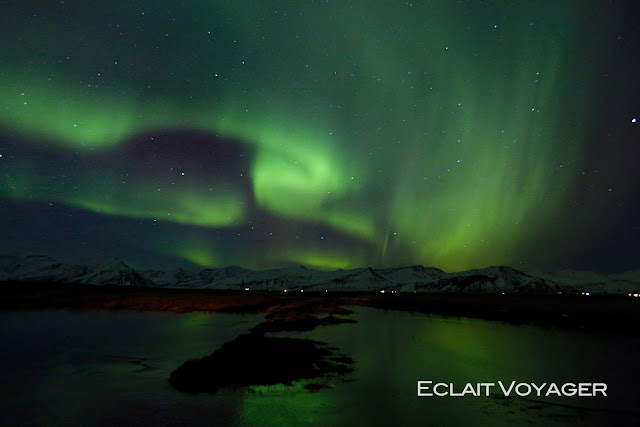The mythical aurora queen, also known as the northern lights, is caused by electronically charged particles from the sun that collide with gas particles in the atmosphere. Different colors are formed depending on the type of the particles. The usual green is caused by low-level oxygen particles, while red is formed by higher altitude oxygen particles. Sometimes, a purplish aurora is formed by nitrogen collisions.
When I visited Iceland, the aurora forecast for two days were about level 5-6, and the skies were super clear. So here are some photography tips:
1. Check the Aurora Forecast
The sky needs to be super clear for you, so do check for cloud coverage, as well as the intensity level. You can find all the detailed information here:
http://en.vedur.is/weather/forecasts/aurora/
2. Minimal Light Pollution and No Moon
Again, there's been some debate on whether having a full moon will impact on seeing the northern light. Here's the verdict -- if you are traveling, you may want to pick dates when there's no moon, so that even if the activity is low, you will have a better chance of seeing the northern light.
In addition, pick a place where there is low light pollution to get the best view possible.
In addition, pick a place where there is low light pollution to get the best view possible.
3. Have your Aperture at Maximum
Whatever camera or lens you have, have the aperture at it's maximum, and pick ISO accordingly. I was using a Leica M262, shooting at F2.4, ISO 3200. Adjust shutter speed accordingly depending on your location and the amount of lighting you can get.
4. Lens type & ISO
Before I embarked on this trip, some people told me that I needed a fisheye, or an ultra-wide lens like 11-16mm. Sure, having an ultra-wide lens or a fisheye may give you the full advantage of getting all in, however, I used a fixed lens 50mm and these are the results I achieved.
Composition matters, and there are no right or wrong answers to it.
For ISO, I try to stick at 3200, in case it gets too grainy.
5. Even if there's little activities, as long as the sky is clear, you can still get a good photo of stars!
Say that you just went out there to test your luck, even if there's little aurora activities, dress warm and get a good capture of the stars and galaxy instead! |
Bonus Point: Choose your foreground and be spontaneous
Some of the best pictures I got were not from the diamond beach or the Jokusalon glacier lagoon, but just off the road in the middle of nowhere.Be spontaneous, don't be afraid to stop when you see a high level activity. You will be surprised by the results! *Note: Be careful and not to set up your camera in the middle of the road.























![[US] Newport Mansions, Gilded Age and Vanderbilts (2) [US] Newport Mansions, Gilded Age and Vanderbilts (2)](https://blogger.googleusercontent.com/img/b/R29vZ2xl/AVvXsEgdLVBJVfOugvhyj0sFWVPv5Wk3XKrRK_Te_9cDQteObCZvGZWvOYiMcFLbacpGN6JNjkwiVhiEFWnUtyjnUp4yRjnZkUaMx3Qa90D0DcjaYgSmgaS-WQxM1LNOIP0MqQgvEiB7cJHQT1tW/s72-c/IMG_5365.jpg)

![[SALZBURG, AUSTRIA]: Marlene Dietrich & Cafe Bazar [SALZBURG, AUSTRIA]: Marlene Dietrich & Cafe Bazar](https://blogger.googleusercontent.com/img/b/R29vZ2xl/AVvXsEj64WeQHrTFP3EJP6V3J749uDFJ63cr321FpEWTcyv3sPmyXoiHpIKcLV5wQ7EArc08AwcW68u6iP0GBxQeAOORA5hTcIye2C1Hw-FCJlrMI10ra53aIYEjXmXRCjMh1ibjXiSEWt8FEW9M/s72-c/IMG_4806.jpg)
![[US] Newport Mansions, Gilded Age and Vanderbilts (1) [US] Newport Mansions, Gilded Age and Vanderbilts (1)](https://blogger.googleusercontent.com/img/b/R29vZ2xl/AVvXsEg38cwMN4jNE72LXybmV93WwFLD25QUgFLfdCO88c1Lnfa-Xp55epQFPXnHWLVP6cdnxUD7sr98_5LDW2s0BBF0N53y81gq4sYF1hOp3bv3We2QlQ9X4LvWn2cE1MhRGzexHpsM-FeWUJOa/s72-c/IMG_5349.jpg)
![[Michelin Restaurant 1*]: Esszimmer [Michelin Restaurant 1*]: Esszimmer](https://blogger.googleusercontent.com/img/b/R29vZ2xl/AVvXsEjx3TfFMYFpukgSZ1DPSMyILiJv8cUZw_371lGNHPMqlUccutFF-ThHaUEug_8rrAkHxnRMkH7e8VxJ2AXhBnCAdmpbtTnFEcKVefCeE_yIVhAzAsdAcvIEHMlgJm8ZD5375tFH6WSMIxwI/s72-c/IMG_5508.JPG)







